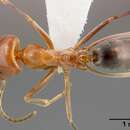en
names in breadcrumbs


Taxonomic history
Gallardo, 1916b PDF: 63 (q.); Crozier, 1970a PDF: 114 (k.).Combination in Dorymyrmex (Conomyrma): Gallardo, 1916b PDF: 63; Smith, 1951c PDF: 837.Combination in Dorymyrmex (Biconomyrma): Kusnezov, 1952j PDF: 430.Combination in Conomyrma: Kempf, 1972b PDF: 78.Combination in Dorymyrmex: Shattuck, 1992c PDF: 85.Subspecies of Dorymyrmex pyramicus: Wheeler, 1910a PDF: 568; Emery, 1913a PDF: 37; Gallardo, 1916b PDF: 63; Cole, 1937b PDF: 136; Cole, 1942 PDF: 372; Creighton, 1950a PDF: 349; Smith, 1951c PDF: 837; Smith, 1958c PDF: 140.Status as species: Kusnezov, 1952j PDF: 430; Cole, 1958b PDF: 130; Wilson, 1958e PDF: 76; Cole, 1966b PDF: 18; Beck et al., 1967: 69; Smith, 1967a PDF: 365; Kempf, 1972b PDF: 78; Snelling, 1973b PDF: 4; Hunt & Snelling, 1975 PDF: 22; Smith, 1979: 1420; Snelling & George, 1979: 169; Dlussky, 1981b PDF: 48; Allred, 1982: 458; Wheeler & Wheeler, 1986g PDF: 57; Johnson, 1989b PDF: 192 (in key); Shattuck, 1994 PDF: 75; Bolton, 1995b: 181; Mackay & Mackay, 2002 PDF: 251; Ward, 2005 PDF: 26; Cuezzo & Guerrero, 2012 10.1155/2012/516058 PDF: 6 (redescription); Bezděčková et al., 2015 PDF: 109; Guerrero, 2019 PDF: 708.Evidence of occasional introgression with D. insanus .
Dorymyrmex bicolor is a species of ant in the Dolichoderinae subfamily, known by some as cone ants due to the shape of their mounds. Dorymyrmex bicolor was recently known as Conomyrma bicolor but has been renamed to Dorymyrmex bicolor.[1] Dorymyrmex bicolor has a single petiole and a slit-like orifice which releases chemical compounds. This ant does not have the capability to sting. Dorymyrmex bicolor is primarily found in arid desert regions in Central and South America and the southwestern United States.[2]
Dorymyrmex bicolor regularly interacts with three different species of Myrmecocystus, another genus of ants. Between the two genera of ants, in the southwestern region, there is much overlap of food sources and space between Dorymyrmex bicolor and Myrmecocystus. The Myrmecocystus ants secrete a substance from their poison gland onto a food source they find in order to repel other ants. Dorymyrmex bicolor exhibits a different type of interference behavior. The workers of Dorymyrmex bicolor will surround the entrance to a nest of Myrmecocystus and will drop stones and other objects down the entrance, in an attempt to block the entrance. As many as 10-30 workers of Dorymyrmex bicolor have been observed to drop stones in an opposing nest, but only 5 workers are required to drop stones and other small objects at an efficient rate that will affect the Myrmecocystus nest. The number of Dorymyrmex bicolor workers in an area will have a reducing effect on the number of Myrmecocystus workers in an area, sometimes to drastic effects.[2]
The known range of Dorymyrmex bicolor stretches from the Southwestern United States (California, Texas, Arizona, New Mexico, and Oklahoma), northern and southern Mexico (including Baja California), El Salvador, Guatemala, Belize, Peru, Honduras, and a few Caribbean island nations (i.e. Jamaica).[3]
Dorymyrmex bicolor has a primarily foraging focused behavior, because of this they are known to influence rates of seed germination and distribution in plants. They move quickly and are active from early to late afternoon. They build crater shaped nests made of fine sand, as they primarily live in desert like areas though they can live in areas with higher humidity levels.[4]
Dorymyrmex bicolor is a species of ant in the Dolichoderinae subfamily, known by some as cone ants due to the shape of their mounds. Dorymyrmex bicolor was recently known as Conomyrma bicolor but has been renamed to Dorymyrmex bicolor. Dorymyrmex bicolor has a single petiole and a slit-like orifice which releases chemical compounds. This ant does not have the capability to sting. Dorymyrmex bicolor is primarily found in arid desert regions in Central and South America and the southwestern United States.